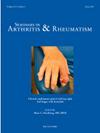Association between Kawasaki disease and subsequent autoimmune disease: National cohort study of adolescents with 12-year follow-up from birth
IF 4.6
2区 医学
Q1 RHEUMATOLOGY
引用次数: 0
Abstract
Background
There is little known about the association of Kawasaki disease with autoimmune diseases. This 12-year follow-up study determined the risk for an autoimmune disease in children who had Kawasaki disease.
Methods
All individuals born in South Korea between 2002 and 2005 were identified using the National Health Insurance Service's (NHIS) database. Incidence density sampling was used to identify 16,398 patients in the exposed cohort (diagnosis of Kawasaki disease between 2002 and 2005) and 163,980 matched (1:10) children in the unexposed cohort. Participants were followed from the date of diagnosis of Kawasaki disease (index date) until the first diagnosis of an autoimmune disease, death, or end of the study (December 31, 2017). Diagnoses of autoimmune diseases were according to ICD-10 codes.
Findings
The median age at the index date was 2.2 years (interquartile range: 1.1–3.7). During follow-up, 1139 children had newly diagnosed autoimmune diseases in the exposed cohort (incidence rate: 59.3 per 10,000 person-years) and 9752 children had newly diagnosed autoimmune disease in the unexposed cohort (incidence rate: 50.4 per 10,000 person-years), corresponding to an absolute difference of 8.9/10,000 person years (95 % CI: 5.3–12.5). Kawasaki disease was also associated with multiple individual autoimmune diseases: juvenile idiopathic arthritis (HR=1.27), Henoch-Schönlein purpura (HR=1.21), polymyositis/dermatomyositis (HR=2.12), vitiligo (HR=1.17), idiopathic thrombocytopenic purpura (HR=2.30), and acute rheumatic fever and chorea (HR=3.35).
Interpretation
Korean children with Kawasaki disease had an increased risk of autoimmune disease during a 12-year follow-up period. These findings suggest a biological relationship between Kawasaki disease and subsequent autoimmune disease.
求助全文
约1分钟内获得全文
求助全文
来源期刊
CiteScore
9.20
自引率
4.00%
发文量
176
审稿时长
46 days
期刊介绍:
Seminars in Arthritis and Rheumatism provides access to the highest-quality clinical, therapeutic and translational research about arthritis, rheumatology and musculoskeletal disorders that affect the joints and connective tissue. Each bimonthly issue includes articles giving you the latest diagnostic criteria, consensus statements, systematic reviews and meta-analyses as well as clinical and translational research studies. Read this journal for the latest groundbreaking research and to gain insights from scientists and clinicians on the management and treatment of musculoskeletal and autoimmune rheumatologic diseases. The journal is of interest to rheumatologists, orthopedic surgeons, internal medicine physicians, immunologists and specialists in bone and mineral metabolism.

 求助内容:
求助内容: 应助结果提醒方式:
应助结果提醒方式:


